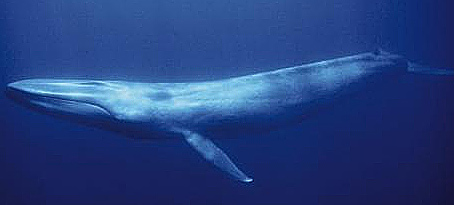Blue Whale – The Largest of All Animals

The blue whale is the largest cetacean and largest animal alive today and perhaps the largest on earth ever. The low decibel song of the blue whale is the loudest made by animals. These loud, low-frequency songs can be heard by other whales over very long distances.
The gigantic whale is for the most part blue on top although along its back it has patches of gray that can shine turquoise or silver when the sun shines. Underneath they can be white, blue or even yellow. The yellow is caused by a layer of diatoms – tiny plants attached to the skin.

When this whale “blows” or exhales on the surface it can be 33 ft (10 m) high. The whale is found in all oceans but migrates to polar waters in search of its primary prey – krill or tiny plankton. And when the go to the krill buffet, they go for the all-you-can-eat variety. In the Antarctic, in one day, a single whale may eat as many as 8 tons of krill. They almost exclusively eat krill; however, occasionally they may eat some crabs in the waters around Baja California. They eat so much at once so that they can go for long periods without eating – up to 8 months, on the reserves they have stored.
They reach sexual maturity at about 10 years and can live up to 90 years. Orca whales are their principle predator, attacking the young and/or sick in groups.
Whale hunting has endangered the existence of the blue whale. Since the blue whale is so big, it was targeted because it would yield so much blubber or oil. They are very vulnerable to climate change or other factors such as pollution affecting the biosystem.
